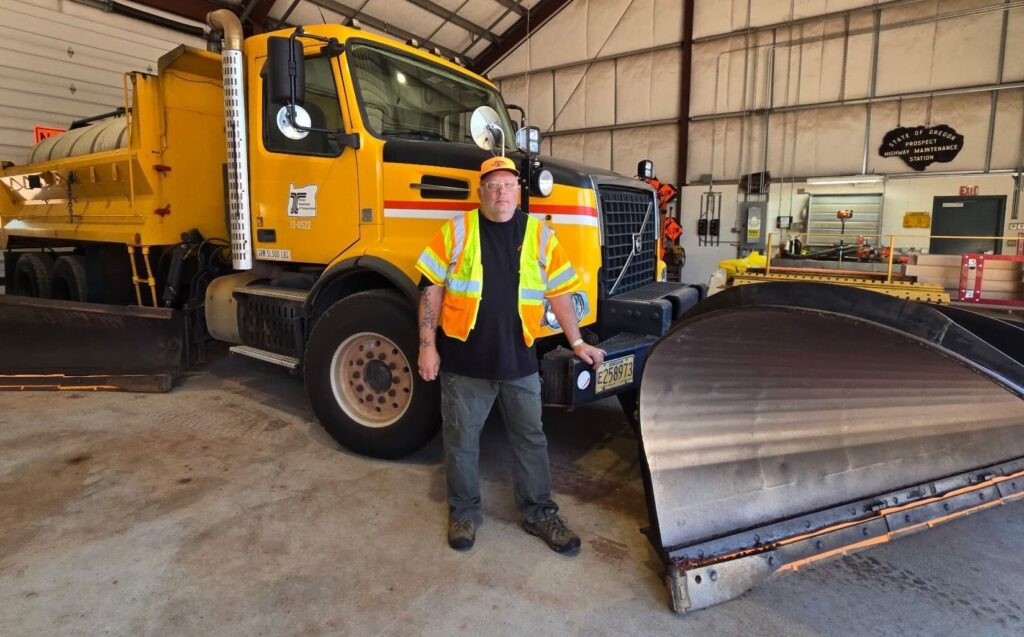Lon Stockebrand has spent nearly 30 years clearing snow off southern Oregon highways. Now he’s afraid he could lose the job in which he takes immense pride.
Stockebrand works as part of a small crew near Crater Lake, as one of many Oregon Department of Transportation employees who maintain thousands of miles of roads, logging
long hours in the winter
and keeping highways safe throughout the year.
After 28 years at the agency, Stockebrand, 64, has learned a few things about winter road upkeep. He knows to steadily steer his snowplow under 30 miles per hour. During winter storms, he prepares for 12-hour shifts. Country music plays loudly in his plow as he looks forward to a dip in his hot tub after work.
“The stereo is blasting, the window’s down because I like cool air in my face, and every once in a while you get a little snow in your face too,” Stockebrand said. “But you know, that’s okay, and that’s kind of what keeps you going.”
Stockebrand said he’s never seriously considered leaving his job, but he worries he won’t have a choice if layoffs come.
That’s because the Oregon Department of Transportation is facing a massive funding problem. Over the past year, its leaders
have urged lawmakers
to find more money for the agency, which is responsible for maintaining more than 7,000 miles of highways and nearly 3,000 bridges statewide.
Without more money, agency leaders have warned they will be forced to close some maintenance stations and lay off roughly 1,000 workers, resulting in higher incident response times and reduced road maintenance across the state.
Those cuts could disproportionately impact rural Oregon communities that rely heavily on those maintenance workers, particularly in the winter. For instance, reducing services could mean some roads no longer get plowed overnight, delaying emergency response vehicles, school buses, truckers and commuters.
Stockebrand and his colleagues are well aware of the potential consequences.
“We’re the ones that keep the roads open,” Stockebrand said. “We’re the ones that fix the potholes, make your bridges safe. … If we lose 600 people in the state of Oregon that normally do these kinds of jobs, what’s going to happen to our roads?”
‘We’re doing the best we can’
No two days of work are the same for Stockebrand and his coworkers based out of Prospect, a sleepy unincorporated community located along Highway 62 about a half hour drive from Crater Lake National Park.
During the summer, the crew might spend a typical day cutting back brush along roads, sealing cracks on asphalt and reinforcing guardrails to prevent drivers from veering off the road. As the days grow colder, they plant tall snow poles in regular intervals along roads, to help guide their snowplows and maintenance vehicles in the coming months.
Stockebrand and his team maintain more than 250 miles of highway in a heavily forested area of rural southwest Oregon that sees significant snowfall most years. The crew typically spends about six months per year clearing snow off roads, but that varies widely. Stockebrand recalls plowing snow off some high-elevation roads as late as July some years.
Following heavy storms or amid prolonged snowfall, Stockebrand and his team shift to an around-the-clock, “all hands on deck” schedule to continue clearing snow off roads and respond to safety hazards at all hours.
“You work 12 (hours) on, 12 off, until Mother Nature gives us a break,” Stockebrand said. “September 21 is my wife and I’s anniversary, and she reminds me all the time that I’ve missed seven of our anniversary days because I’ve been out plowing snow.”
Snow maintenance vehicles operated by the Oregon Department of Transportation move forward on a snow-covered road.
Courtesy of Lon Stockebrand
Those long, cold shifts typically involve Stockebrand driving one of several vehicles designed to clear away snow, form grooves in the snow and spread sand or deicer on roadways to improve tire traction and melt accumulated precipitation.
He might spend an entire shift switching between these large vehicles and driving back and forth over the same stretch of road, often amid limited visibility, dropping sand and watching out for hazards.
The job comes with risks. Over the years, Stockebrand has been involved in three head-on crashes while driving snowplows in winter conditions. None of the crashes resulted in serious injuries for either party, he said.
The small team of maintenance workers keep the roads safe, not only for local workers and families, but for out-of-state visitors and long haul truck drivers too.
Crater Lake National Park receives half a million visitors per year, many of whom come during winter months to ski, snowshoe and take pictures of the frosty landscape. A large number of them arrive on roads maintained by Stockebrand and his crew.
But it only takes one vehicle crashing or a semitruck spinning out to disrupt that flow of traffic. Stockebrand and his crew respond to such incidents, which might necessitate a temporary road closure or other traffic changes to ensure the safety of drivers and first responders.
The biggest challenge of Stockebrand’s job, he said, is dealing with upset members of the public who view these safety measures as inconvenient and cast blame on him or his colleagues.
“The customers get angry at us because it wasn’t perfect for them, and that’s the hardest part of my job,” he said. “We’re doing the best we can.”
A lifetime of public service
Stockebrand has lived in Prospect nearly his entire life, since his family first moved from Kansas to southern Oregon in the 1960s. He attended the local public K-12 school and was in a graduating class of 15.
Stockebrand was first drawn to public service in high school, when he started volunteering for the local fire department. For decades, he helped the department in his off time, stopping only after being diagnosed with asthma. He also spent 35 years as a volunteer with the Jackson County Search and Rescue team.
After high school, Stockebrand first found work as an independent trucker in the logging industry. But he soon applied to the state transportation agency, pushed out by a decline in the logging industry and pulled in by the
paid holidays
and health benefits.
It turned out to be the perfect fit.
The benefits of his job are numerous, Stockebrand said. He lives one mile from his workplace. He gets to help train and support younger workers. And his team gets to help the public arrive at their destinations safely and on time.
“You might be traveling through my highway, and I want you to be as safe as I can possibly make it for you,” he said. “All of our crew here in Prospect feel that way. It’s our pride to be out there.”
Over the years, Stockebrand has served as a trainer in various programs for state workers. He has helped younger employees learn how to operate heavy machinery like snowplows and excavators and taught workers to properly cut down hazardous trees.
For the past 16 years, Stockebrand has also served as a local union steward for the state agency, helping his coworkers understand their benefits and ensuring workplace disputes are appropriately handled.
“That’s kind of a niche I found in life — trying to help others,” he said.
Crater Lake National Park, pictured on April 16, receives hundreds of thousands of visitors each year. Most of them arrive on roads maintained by Oregon Department of Transportation workers.
Janet Eastman/The Oregonian/OregonLive
Funding discussions, consequences
Meanwhile, lawmakers in Salem are
debating a bill
that will decide whether hundreds of workers like Stockebrand will get to keep their jobs.
Leaders of the Oregon Department of Transportation have said the agency needs a major infusion of cash this year to avoid cutting services. Last year, agency leaders told state officials they would have to lay off roughly 1,000 of the agency’s 4,900 employees without more funding in the next biennium, which will begin in July.
While some affected employees would be workers like Stockebrand, other layoffs would target administrative positions at the agency. Multiple reviews in the past year have uncovered numerous
bureaucratic inefficiencies
that have significantly delayed work throughout the agency.
Their request was not a complete surprise to lawmakers. In late 2023, Gov. Tina Kotek and top Democrats in the Legislature decided to allocate an additional $19 million to the agency for winter road plowing and maintenance after its leaders said it could not afford to fully fund those services.
Lawmakers of both parties agree that finding money to maintain Oregon’s roads and bridges is a top priority this year. But with only weeks left in the legislative session, they have still not found consensus on a package to secure those dollars.
Democrats, who control both chambers, have said any major transportation package this year will include new or increased taxes to shore up funding for the transportation agency. But nearly every lawmaker in the party has a
different take
on what those tax hikes should be and where the money ought to go.
Republicans, meanwhile, have mostly expressed
loud opposition
to any tax hikes, saying that they support funding the Oregon Department of Transportation’s core services like road maintenance but want to cut other programs at the agency outside of that scope.
With their three-fifths supermajorities, Democrats could theoretically increase taxes with no Republican support if every Democrat voted in favor. But it’s unclear if they are willing to do so, or if they will have enough votes to do so in the House, where one Democrat has been absent for months while undergoing cancer treatment.
This week, Democrats finally unveiled a bill that would increase funding for the state transportation agency. But it is likely going to undergo several changes before advancing to a vote. Lawmakers have until June 29, the constitutionally mandated end of the legislative session, to pass a bill.
Stockebrand is closely watching to see what happens. As a worker, he’s worried about losing his job. As a husband and neighbor, he’s concerned that the roads in his area won’t get plowed as often and responders won’t get to crashes as quickly.
He knows many members of his community are wary of tax hikes or not paying attention to the distant political drama in the state Capitol. But they don’t always realize that the bills moving through Salem directly impact basic services like the upkeep of the roads between their driveway and the nearest grocery store, he said.
“I’m the one in that yellow truck with the blinky lights that’s in your way, trying to fill a pothole,” Stockebrand said. Without those workers, he said, “we’re not going to have the people here to take care of the road for my family and for you to travel next season.”
— Carlos Fuentes covers state politics and government. Reach him at 503-221-5386 or
cfuentes@oregonian.com
.
Latest local politics stories
-
Lawmakers compromise on 10 weeks of unemployment for striking workers, not 26
-
Bill to require big tech to pay Oregon newsrooms advances with fewer legal concerns
-
Lawmakers advance contentious bill to reset child abuse rules on party line vote
-
Washington County to approve six-figure payout for CEO who resigned from embattled sewer agency
-
Oregon early learning, child care programs poised for $45 million in cuts





More Stories
‘It’s our pride to be out there’: Oregon Department of Transportation worker braces for layoffs
‘It’s our pride to be out there’: Oregon Department of Transportation worker braces for layoffs
‘It’s our pride to be out there’: Oregon Department of Transportation worker braces for layoffs